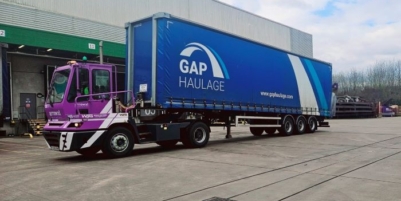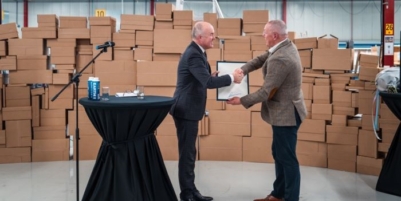-
Nutrivend selects Forterro’s Orderwise to support online expansion and streamline operations - April 11, 2025
-
ARROWXL LAUNCHES AMBITIOUS ZERO WASTE ROADMAP - April 8, 2025
-
THE BCMPA’S NEW CAMPAIGN DRIVES OUTSOURCING SUCCESS IN Q1 - April 7, 2025
-
BLACKOUT TECHNOLOGIES TARGETS TELEMATICS-INTEGRATED MOBILE DEVICE BLOCKING TO COMBAT SMARTPHONE DISTRACTION - April 1, 2025
-
Sparck Technologies awarded Royal designation - March 27, 2025
-
OpenADR Alliance announces first OpenADR 3.0 certified products with EVoke Systems, E.ON Energy and Universal Devices - March 25, 2025
-
Growing fulfilment and contract packer appoints new Managing Director - March 25, 2025
-
When is it time to invest in a WMS? Understanding the key trigger points - March 25, 2025
-
eCapital helps Vantage Recruitment on its journey to financial success - March 24, 2025
-
Hugo Beck Celebrates 70 Years of Packaging Innovation with Open House Events - March 20, 2025
Economic conditions could not be more precarious for manufacturers and retailers as we enter the autumn and winter 2022 festive seasons. The current economic landscape features all of the supply chain problems experienced in the past few pandemic years – disrupted availability, skill and labour shortages and rising costs due to increased demand and salary expectations due to increased inflationary pressures.
Now in 2022 the upcoming peak season, which begins with Black Friday on 25 November, faces some new challenges. There are unprecedented increases to energy and raw materials costs- in part due to geopolitical instability and the global cost of living crisis. Consumers have not been as worried about ‘affording the basics’ for many decades and the phrase ‘Heat or eat’ is frequently being used to sum up the harsh reality for many.
Somehow, against this difficult backdrop, UK retailers and manufacturers need to ensure that the forthcoming festive period, a time when many businesses need to secure their biggest sales, goes as profitably as possible. Here are 5 reasons why the 2022 season will be more challenging and why it is important to optimise inside the 4 walls of your warehouse:
Increased cost of living
Households are being hard hit by higher food prices, influenced by geopolitical instability and supply shortages. Some analysts have predicted that consumers will cut back on expenditure this season and demand planning has been much more difficult. Where businesses have erred on the side of caution, there may be shortages or delays taking receipt of drop-shipped items.
Skills shortages
Fewer available workers in warehouses, logistics providers and core utility services have already pushed up wage rates and now there is industrial action to contend with. Strikes, such as the ongoing UK railway and postal strikes, are impacting deliveries of raw materials and also shipments. Dock workers have been on strike and if there is further action, this will cause further disruption to supply chains right at a time when demand is highest.
Energy shortages
Every type of good we use has been hit by price inflation and this includes energy costs. Due to rising gas prices and reduced supply from Russia, some suppliers may be forced to scale back production or partially discontinue business operations, as threatened in Germany. This international disruption will have a negative impact on UK manufacturing supply chains. Even countries that do not rely on energy supplies from Russia are responding to energy price rises. Pakistan has cut its work week to lower energy demand and in Norway, fertiliser production has been slashed, affecting food supply chains. In the UK, it is the automotive sector that could see further production uncertainty. Reduced power availability is hitting car makers because components supplied by China are in short supply.
Geopolitical uncertainty
Touched upon already, the war in Ukraine is having an impact on energy and food price inflation, creating problems for food manufacturers and disruption for supply chains. So serious are the shortages, that manufacturers are actively seeking alternatives to key raw ingredients – wheat and sunflower oil being prime examples – to protect their businesses from the long term effects. Hostilities between countries are also having an impact on availability. For instance, supply chains that deliver semi-conductors to computers manufacturers are experiencing some delays.
Extreme weather
Even climate change has impacted the supply chain. Extreme temperatures in Europe caused fires and ‘melting roads’, with droughts elsewhere causing water levels to drop, impacting shipping supply routes. In China, parts of the Yangtze river, used for transporting 45% of the country’s economic output, have been closed to ships because water levels are 50% below normal. This has an obvious impact on freight volumes being shipped to manufacturers and retailers.
All these issues highlight just how interconnected today’s world is and the extreme complexity of modern supply chains. Although many of these macro issues are beyond the immediate control of business owners, there are still plenty of ways to improve operational efficiency within the 4 walls of a warehouse, by investing in warehouse management system (WMS) software. Here are three quick wins your business can benefit from now.
Store goods more efficiently using less warehouse space
Increasing inflationary pressures is affecting warehouse rental rates. Rising prices and property shortages mean warehouse space is getting more and more expensive. A best of breed WMS can help you make more efficient use of your warehousing space, with up to 20-30% savings possible. For example, an effective put-away process is an important stock management strategy to maximise space utilisation. There are multiple ways a WMS can automate putaway, by identifying the best place to store items based on available spaces, monitoring how frequently items will be picked and where they should be placed in the warehouse, and whether items need special storage considerations.
Automate routine and repetitive tasks
A WMS will automate many routine and repetitive processes in the warehouse, which in turn helps to minimise the impact of labour shortages and higher wage costs. Employees can frequently represent up to 50% of warehousing costs and a WMS will mitigate the impact of human errors, plus optimise resource utilisation. The potential savings can be very significant.
Integrating Processes
One common observation in a warehouse is what Indigo Software describes as ‘anarchy masquerading as flexibility’. Processes are not fully integrated, there are different suppliers and systems in place with a lack of standardisation. Anywhere there is a lack of integration, there are hidden costs. For example, a company might use a range of different systems to manage parcel shipments rather than having a single integrated and standardised process. The extra costs inherent within a disintegrated process become magnified when inflation is increasing. It can also compromise the quality of data, which in turn negatively impacts sales order entry, planning, production, and customer satisfaction.
Ultimately, a WMS cannot completely shield your business from challenges in the macro economic environment, but they can most definitely provide a high level of insulation. Indigo WMS can help you become super canny about minimising costs, so that your resources can stretch further, and profits are less impacted.
Author: Eric Carter, Solutions Architect, Indigo Software
































